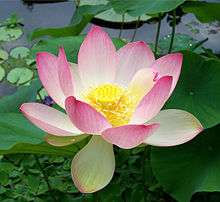Yaśodharā
| Yaśodharā | |
|---|---|
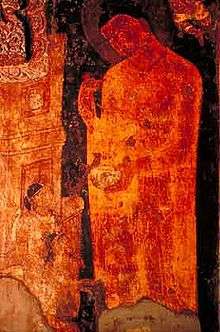 Buddha with Yashodhara and Rahula (left bottom), Ajanta | |
| Born | Devdaha |
| Spouse | Gautama |
| Father | Suppabuddha |
| Mother | Amita |
| Religion | Buddhism |
| Occupation | bhikkhuni |
| Part of a series on |
| Buddhism |
|---|
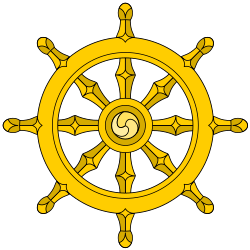 |
|
Yaśodharā (Pali: Yasodharā) was the former wife of Gautama Buddha —before he left his home to became a śramaṇa—, the mother of Rāhula, and the sister of Devadatta. She later became a bhikkhunī and is considered an arahatā.
Life
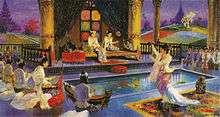
Yaśodhara was the daughter of King Suppabuddha,[1][2] and Amita, sister of the Buddha's father, King Śuddhodana. She was born on same day in the month of "Vaishaka" as Prince Gautama. Her grandfather was Añjana a Koliya[3] chief, her father was Suppabuddha and her mother, Pamitā, came from a Shakya family. The Shakya and the Koliya were branches of the Ādicca or Ikshvaku dynasty. There were no other families considered equal to them in the region and therefore members of these two royal families married only among themselves.[4]
She was wedded to her cousin, the Shakya prince Siddhartha, when they were both 16. At the age of 29, she gave birth to their only child, a boy named Rāhula. On the 7th night of his birth, the Prince left the palace. Yaśodharā was devastated and overcome with grief. Buddha left his home at night for enlightenment, without letting sleeping Yashodhara know about him. In the morning when she woke up she didn't see him. Hearing that her husband was leading a holy life, she emulated him by removing her jewellery, wearing a plain yellow robe and eating only one meal a day.[5] Although relatives sent her messages to say that they would maintain her, she did not take up those offers. Several princes sought her hand but she rejected the proposals. Throughout his six-year absence, Princess Yaśodharā followed the news of his actions closely.
When the Buddha visited Kapilavastu after enlightenment, Yaśodharā did not go to see her former husband but ask Rahula to go to Buddha to seek inheritance. For herself, she thought: "Surely if I have gained any virtue at all the Lord will come to my presence." In order to fulfill her wish, Buddha came into her presence and admired her patience and sacrifice.
Some time after her son Rāhula became a novice monk, Yaśodharā also entered the Order of Monks and Nuns and within time attained the state of an arahat. She was ordained as bhikkhuni with the five hundred women following Mahapajapati Gotami that first established the bhikkhuni order. She died at 78, two years before Buddha's parinirvana (death).[6]
Legends
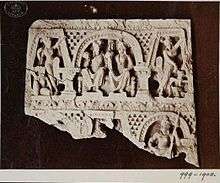
.jpg)
In the Chinese: 佛本行集經, The Collective Sutra of the Buddha's Past Acts, Yashodharā meets Siddhārtha Gautama for the first time in a previous life, when as the young brahmin Sumedha Buddha, he is formally identified as a future Buddha by the buddha of that era, Dīpankara Buddha. Waiting in the city of Paduma for Dīpankara Buddha, he tries to buy flowers as an offering but soon learns that the king already bought all the flowers for his own offering. Yet, as Dipankara is approaching, Sumedha spots a girl named Sumidha (or Bhadra) holding seven lotus flowers in her hands. He speaks to her with the intention of buying one of her flowers, but she recognises at once his potential and offers him five of the lotuses if he would promise that they would become husband and wife in all their next existences.
In the thirteenth chapter of the Lotus Sutra, Yaśodharā receives a prediction from Gautama Buddha as does Mahapajapati.[7]
Names
The meaning of the name Yaśodhara (Sanskrit) [from yaśas "glory, splendour" + dhara "bearing" from the verbal root dhri "to bear, support"] is Bearer of glory. The names she has been called besides Yaśodharā are: Yaśodharā Theri (doyenne Yaśodharā), Bimbādevī, Bhaddakaccānā and Rāhulamātā (mother of Rahula).[8] In the Pali Canon, the name Yaśodharā is not found; there are two references to Bhaddakaccānā.[9]
See also
References
- ↑ "IX:12 King Suppabuddha blocks the Lord Buddha's path". Members.tripod.com. 2000-08-13.
- ↑ "Dhammapada Verse 128 Suppabuddhasakya Vatthu". Tipitaka.net.
- ↑ "Koliyā". Palikanon.com.
- ↑ Why was the Sakyan Republic Destroyed? by S. N. Goenka (Translation and adaptation of a Hindi article by S. N. Goenka published by the Vipassana Research Institute in December 2003, archived)
- ↑ "The Compassionate Buddha". Geocities.com. Archived from the original on 2009-10-21. Retrieved 2009-09-23.
- ↑ The Lord Buddha and His Teachings
- ↑ Lotus sutra including chapter thirteen Translated by The Buddhist Text Translation Society in USA)
- ↑ French text: Yashodhara (glorieuse) est la cousine et l’épouse principale de Gautama, mère de son fils Rahula. Connue par les Jatakas (légendes de la vie du Bouddha), elle serait devenue du vivant de Gautama une ascète, une nonne prééminente et l’un des quatre arahants de son entourage possédant l’intuition absolue 1. Les détails de sa légende sont de nos jours surtout populaires dans le bouddhisme theravada. Elle est également nommée Yashodhara Theri (doyenne Yashodhara), Bimbadevi, Bhaddakaccana ou Rahulamata (mère de Rahula).
- ↑ AN 1. 14. 5. 11 states: "Etadaggaṃ bhikkhave mama sāvikānaṃ bhikkhunīnaṃ mahābhiññappattānaṃ yadidaṃ bhaddakaccānā" (SLTP). Bv, PTS p. 65, v. 15 states: "Cattārīsa sahassāni nāriyo samalaṅkatā / Bhaddakaccānā2 nāma nārī rāhulo nāma atrajo" (SLTP).
- The Buddha and His Teaching, Nārada, Buddhist Missionary Society, Kuala Lumpur, Malaysia, 1988, ISBN 967-9920-44-5
Literature
- The First Buddhist Women: Translations and Commentaries on the Therigatha Author: Susan Murcott, ISBN 0-938077-42-2
- Life of Princess Yashodara: Wife and Disciple of the Lord Buddha Author: Devee, Sunity, ISBN 978-0-7661-5844-3 (13), ISBN 0-7661-5844-6 (10), KESSINGER PUB CO
- Yashodhara: Six Seasons Without You, by Subhash Jaireth, Wild Peony Pty Ltd, Broadway, NSW, Australia, 2003, ISBN 1-876957-05-0
- Stars at Dawn: Forgotten Stories of Women in the Buddha's Life, Author: Wendy Garling, Shambhala Publications 2016, ISBN 978-1-61180-265-8
External links
- A Mysterious Being: The Wife of Buddha by Professor Andre Bareau, Université de France (Translated by Kyra Pahlen), the apparent source being a series of three articles published as Recherches sur la biographie du Buddha, Presses de l'École française d'extrême-orient, 1963, 1970 & 1971. (archived 2011)
- Dipankara meets Sumitta and Sumedha (archived 2011)
- Mahásammata (archived 2012)
- The Life of Princess Yashodara: Wife and Disciple of the Lord Buddha
- Cover 1929
- Immediate Family of the Buddha, 4. Yaśodhara by Radhika Abeysekera
- Theri (500s-200s BCE) Other Women's Voices (archived 2011)
- Jacqueline Kramer, director of the Hearth Foundation (2010). "Yashodhara and Siddhartha. The Enlightenment of Buddha's Wife" (PDF). Turning Wheel - The Journal of Socially Engaged Buddhism. Summer: 10–13. Archived (PDF) from the original on 12 August 2014.
